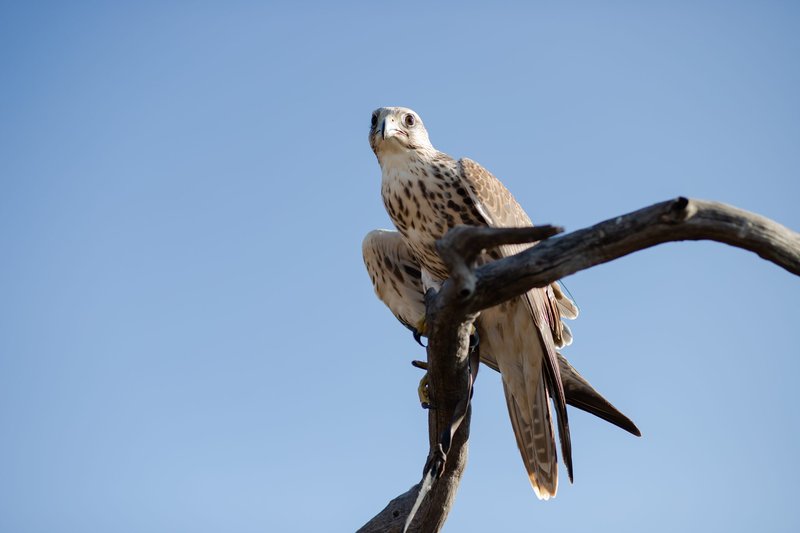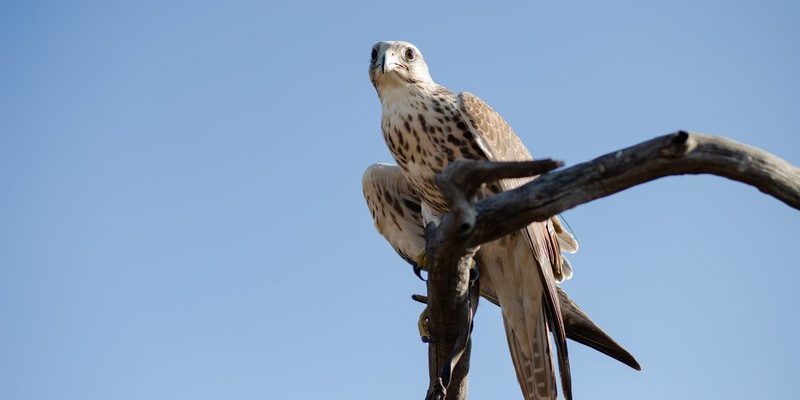
The Saker Falcon, or Falco cherrug, roams over vast areas of Europe and Asia, offering a perfect blend of beauty and power. They’re known for their swift, agile flight and keen eyesight, which help them spot prey from high in the sky. Now, let’s dive into ten interesting facts about these remarkable birds that might just change the way you view them.
1. Unique Habitat Preferences
The Saker Falcon is more than just a pretty face; it’s a bird that thrives in diverse habitats. These falcons typically prefer open landscapes, making their homes in grasslands, steppes, and even agricultural fields. Imagine a vast field with a golden hue under the sun, where these birds can easily spot their next meal.
Interestingly, they also adapt well to urban settings. You might find them nesting in tall buildings or structures, blending the wild with modern life. This adaptability is a testament to their resilience as a species. They certainly know how to make the best of their circumstances.
2. Impressive Size and Appearance
One look at the Saker Falcon, and you’re bound to feel a mix of awe and admiration. These birds are relatively large compared to other falcons, with a wingspan that can reach up to 47 inches. They have a robust body and long wings that are built for speed and agility. Their plumage features a beautiful mix of brown shades, accented with darker markings that enhance their striking appearance.
To put it simply, they look like they mean business. You can almost imagine them gliding effortlessly over the terrain, ready to swoop down on unsuspecting prey. It’s this impressive build that makes them such successful hunters.
3. Hunting Techniques That WOW
You might be wondering how the Saker Falcon catches its dinner. Well, these birds are incredibly skilled hunters, using a mix of stealth and speed. They usually hunt in pairs or small groups, which allows them to coordinate their attack on larger prey.
When they spot something tasty, like a small mammal or bird, they dive down at astonishing speeds, sometimes reaching up to 150 miles per hour! That’s quicker than most cars on the highway! Their sharp talons and beaks are designed for gripping and tearing into their prey effectively. Talk about a dinner with a view!
4. Social Creatures
Unlike many solitary raptors, Saker Falcons have social tendencies, especially during the breeding season. They often hunt in pairs or family groups, which is pretty unique for birds of prey. This social behavior helps them increase their hunting success, as they can corner or distract their prey more effectively.
In fact, during the nesting period, they’re known to work together to build elaborate nests. They may reuse old nests from other birds or create their own in tall trees or cliffs. You can think of them as the “community builders” of the falcon world!
5. Stunning Migrations
Saker Falcons are known for their intriguing migratory patterns. While some stay put year-round, many will travel significant distances to find the perfect winter haven. For those that migrate, their journey can stretch thousands of miles across Europe and Asia.
This migratory behavior ensures they have access to abundant food sources and suitable breeding sites. It’s like knowing when to pack your bags for a vacation! Their navigation skills are impressive, relying on a mix of instinct and keen observation to find their way.
6. Conservation Status and Threats
Here’s the thing: while the Saker Falcon is a magnificent bird, it faces several challenges in the wild. Due to habitat loss, hunting, and climate change, their populations have been declining in some regions. They’re currently classified as near threatened, which is a cause for concern.
Many organizations are working to protect these birds through conservation efforts, focusing on habitat preservation and raising awareness. After all, losing a species as remarkable as the Saker Falcon would be a loss for all of us.
7. Cultural Significance
In various cultures, the Saker Falcon has held a special place. In some regions of the Middle East, it symbolizes strength and courage, often featured in art and literature. People have even trained them for falconry, a traditional sport that showcases their incredible hunting abilities.
This deep-rooted cultural connection highlights just how significant these birds are beyond their biological importance. They remind us of the bond between humans and nature, and how we can appreciate and respect wildlife.
8. Breeding and Nesting Habits
When it comes to raising a family, Saker Falcons are quite dedicated. They typically mate for life, which isn’t very common among birds. During the breeding season, they engage in elaborate courtship displays that involve aerial acrobatics and vocalizations to attract a mate.
Once paired, they build their nests in high places, often reusing old nests from other birds. The female will lay three to six eggs, and both parents share the responsibility of incubating and feeding their young. It’s heartwarming to see such teamwork in action!
9. Diet Diversity
Saker Falcons have a varied diet, which really showcases their adaptability as hunters. They primarily feed on small mammals like voles and rabbits, but they’re also known to take birds, reptiles, and even insects when necessary.
This flexibility is one reason why they thrive in different environments. It’s like having a favorite restaurant but also being a fan of home-cooked meals—you enjoy variety! Their diverse diet allows them to adjust based on what’s available, making them resourceful hunters.
10. Fascinating Communication
Finally, let’s touch on how Saker Falcons communicate. These birds use a range of vocalizations to express themselves, from soft whistles to loud calls. Each sound can convey different meanings, whether they’re signaling danger or attracting a mate.
But it’s not just about the sounds; they also use body language. Wing displays, head movements, and even the position of their feathers can all signal something to other birds. It’s like having a secret language only they understand!
In conclusion, the Saker Falcon is more than just a bird; it’s a symbol of resilience and strength in the wild. Their unique behaviors and impressive adaptations make them stand out in the avian world. So, next time you spot one soaring through the sky, take a moment to appreciate the marvel that it truly is!

